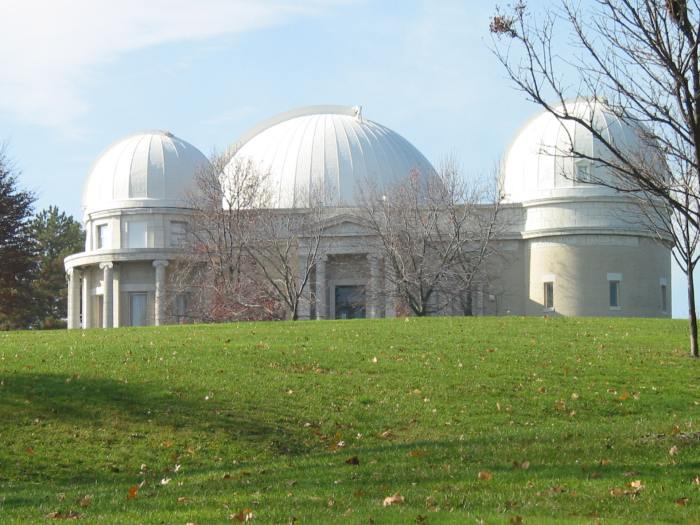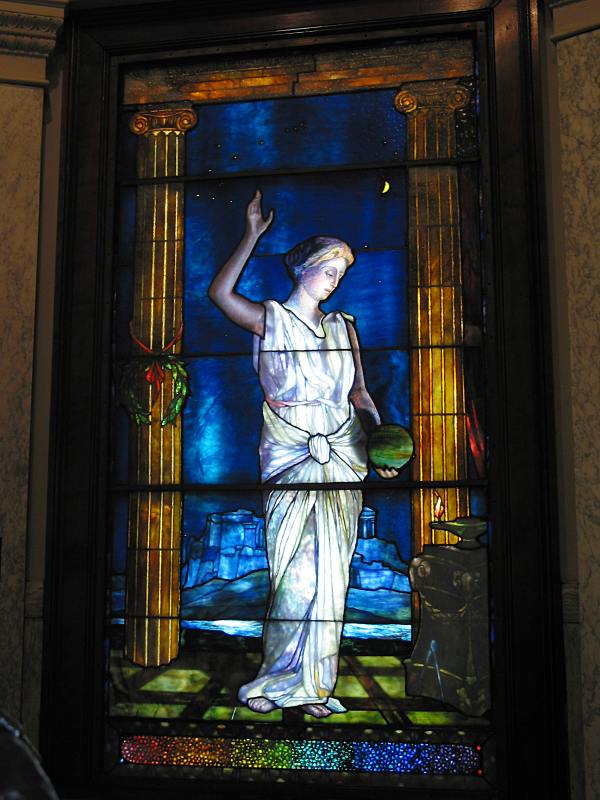
Mary Elizabeth Tillinghast (1845-1912), New York
Mary Elizabeth Tillinghast (1845-1912), New York: Urania, 1903, Allegheny Observatory; T. E. Billquist, architect
Photographs and text copyright © 2007 Pittsburgh History & Landmarks Foundation
The Allegheny Observatory, established in 1859 and given in 1867 to Western University of Pennsylvania (later the University of Pittsburgh), hired architect T. E. Billquist to design a new building on a more advantageous site in 1899. Billquist’s American Renaissance observatory is a scientific acropolis—a tan brick and white terra cotta hill-top temple whose Classical forms and decoration symbolize the unity of art and science. At the core of the building is a small rotunda, housing an opalescent glass window depicting Urania, the Greek muse of astronomy.
Director Frank L. O. Wadsworth, of the observatory of the Western University of Pennsylvania, announced last evening the arrival of a stained glass window from New York as the gift of the Misses Smith, who have devoted a generous sum to the establishment of the observatory. Prof. Wadsworth says the window is to adorn the new structure of the observatory. It is pronounced one of the most artistic works of Miss Mary E. Tillinghast.
The window, which is 9 x 3 feet, shows Urania, almost lifelike, standing in an open porch. Her garb is of the ancient Grecian fashion; in one hand she holds a planet, the other being raised to the heavens. Beside her resting against a pedestal is a pair of compasses; on the pedestal is the lamp of knowledge, whose flames lighten the figure. She stands between two columns. Around one is a wreath of laurel.
Far behind her, in the moonlight, are the ruins of the Acropolis. Shining in the sky and placed relatively with astronomical precision are the moon, the evening star, planets of Pleiades. Under the figure is a delicately blended spectrum, typifying the work of the observatory.
Pittsburgh Post, 3 July 1903
The donors were well-to-do philanthropic siblings, Jane Smith (1832-1911) and her sister Matilda (1837-1909), enthusiastic supporters of the University. The artist was Mary Elizabeth Tillinghast (1845-1912) of New York City. Like many American artists of the period, she spent several years in Europe, visiting Italy and studying painting in Paris. One of her teachers, Emile-Auguste Carolus-Duran, also taught the most famous American painter of the era, John Singer Sargent.
In 1878 Tillinghast began a seven-year affiliation with New York artist John La Farge (1835-1910)—painter, muralist, critic, and inventor of a new process for making decorative glass windows. Tillinghast became an expert textile designer, served as manager of the La Farge Decorative Art Company, and learned the art of designing and making windows from La Farge.
La Farge patented his opalescent window glass in 1880: “The object of my invention is to obtain opalescent and iridescent effects in glass windows . . . softening the light, and, by reason of its unevenness of structure and formation [prevent] the direct passage of rays of light.” La Farge claimed that his glass had the “great advantage as to realistic representation of natural objects.” This new glass was known at the time as “American Glass.” Barbara Weinberg notes that La Farge developed it in order to “reconcile the color and brilliance of early glass with contemporary desires for naturalistic form . . . , to permit depiction of rounded forms and convincing space.” American Renaissance painters admired the spatial realism introduced by Raphael and 15th-century Renaissance painters, and sought to emulate it—in paintings and in glass windows.
Tillinghast’s first major window, Jacob’s Dream, was installed in 1887 in Grace Episcopal Church, New York City. She worked from her Greenwich Village studio, primarily as a window designer, but she also designed furniture and, in one case, was architect, decorator, and glass artist for a private chapel. Her glass was exhibited and won gold medals at several World’s Fairs. In addition to church windows, she designed windows for residences, and for institutions, most notably Urania in Pittsburgh and The Revocation of the Edict of Nantes (1908) in the New York Historical Society.
The year before Tillinghast’s Urania was installed in the Observatory, Fortune by La Farge was installed in D. H. Burnham’s Frick Building in downtown Pittsburgh; both windows portray female figures framed by Classical columns—decorative art echoing the Classical architecture of the building.
The Allegheny Observatory was the first major Pittsburgh building by Thorsten E. Billquist (1867-1923). Billquist was born in Sweden and studied at the University of Gothenburg. He arrived in the United States in 1887 and appeared in Pittsburgh in 1893. Little is known about his activities during this six-year period, but he is said to have worked on the Boston Public Library for McKim, Mead & White, the firm most closely identified with the American Renaissance. In Pittsburgh, Billquist spent a year as a draftsman with Longfellow, Alden & Harlow, then another year in the office of W. Ross Proctor, an early graduate of Columbia University’s Beaux-Arts-derived curriculum. He practiced from 1897 to 1923; from 1905 to 1909 in partnership with Edward B. Lee, who had studied at the École des Beaux-Arts in Paris. Billquist is best known for elegant Colonial Revival and Neo-Classical residences in Pittsburgh’s East End.
Sources: “Window for Western Observatory,” Pittsburgh Post, 3 July 1903. “Woman Stained Glass Artist: Mary Tillinghast’s Work in Pittsburgh and Other Cities.” Pittsburgh Post, 15 July 1906. H. Barbara Weinberg, “John La Farge and the Invention of American Opalescent Windows,” Stained Glass 67 (Autumn 1972): 4-11; and “The Early Stained Glass Work of John La Farge (1835-1910),” Stained Glass 67 (Summer 1972): 4-16. L. A. Richards, “An Unworthy Obscurity,” Stained Glass 89 (Spring 1994): 35-41, 51-52. Albert M. Tannler, “‘Temple of the Skies’: Observatory Hill Renaissance of Art and Science,” Pittsburgh Tribune-Review Focus 30:15 (February 13, 2005): 8-10.
Illustrations
- Allegheny Observatory
- Urania


